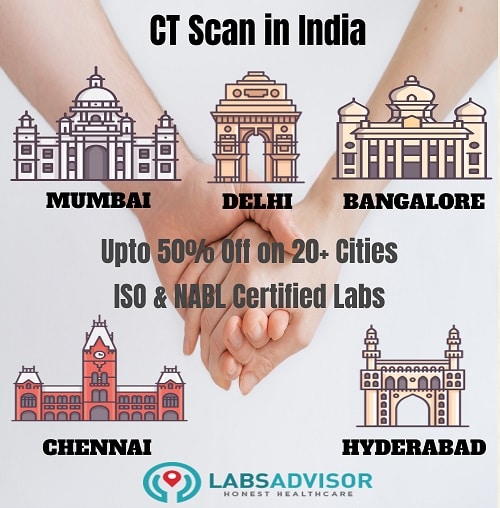
CT scan stands for computerized tomography scan also known as CAT (Computerized Axial Tomography scan). It is a medical testing procedure that needs advanced computers and rotating Ct Scan (using X-ray) machines to produce cross-sectional images of various parts of the body. These images are called slices that provide more detailed information than a normal X-ray or Ultrasound images.
Book this really important test at your local top quality labs through us at up to 50% discount. The lowest CT scan cost in India is ₹1200 only.
CT Scan in India Through LabsAdvisor
|
CT Scan Cost in India & Lab Details
Below is the list of top CT Scans cost in India, please click on the link of the CT scan you want and you can see all the labs near you and book online.
You can also select the time slot suitable for your CT scan. Click on the links below to book anytime, 24 hours a day.
Frequently Asked Questions About CT Scan
What is a CT Scan?
CT scan stands for computerized tomography scan also known as CAT (Computerized Axial Tomography scan). It is a medical testing procedure that needs advanced computers and rotating Ct Scan (using X-ray) machines to produce cross-sectional images of various parts of the body. These images are called slices that provide more detailed information than a normal X-ray or Ultrasound images.
A CT scan scan the inner soft tissues, blood vessels, and bones in a human body. It can be used to study almost all parts of your body, including chest, belly, pelvis, or an arm or leg. It can produce detailed D pictures of all the organs including the liver, pancreas, intestines, kidneys, bladder, adrenal glands, lungs, and heart. It can widely scan the details of blood vessels, bones, and the spinal cord.
Generally, doctors recommend CT scans to look for broken or fractured bones, cancers, blood clots, various heart disease, or severe internal bleeding. It helps the doctor in diagnosing cancer, cardiovascular and infectious disease, appendicitis, trauma and musculoskeletal disorders. A CT scan is used to visualize nearly all parts of the body and can help in diagnosing various diseases, injuries or to plan medical, surgical or radiation treatment.
Typically CT scans are done in hospitals or Radiology labs by the radiographers who are specially trained. CT scan machine seems like a huge doughnut with an attached examining table out of it. The patient is asked to lie on the narrow table that will slide inside and out of the hole in the middle of the huge machine. There are attached sets of multiple cameras and X-Ray detectors in the arc of the machine that captures multiple pictures of the body part that is intentionally viewed in the machine.
The pictures are subjected as information of the affected part of the patient and are reflected on the computer monitored by the technologist. The information is combined to generate a 3D scan. Unlike a traditional X-ray, a CT scan gives much clearer images and is able to distinguish between tissues inside the organs.
What are the different kinds of CT Scans?
CT scanners first began to be equipped in hospitals in 1974. CT scan machine has been improving steadily while making it more comfortable for the patients. Improvements have led to higher-resolution images which give more effective results and take lesser time. It helps in assisting the doctor while diagnosing and visualizing even small nodules or tumors, which cannot be seen on a plain film X-ray report.
Generally, a CT scan is divided into 4 categories:
- Normal CT Scan/ Non-contrast CT: If you have been prescribed an NCCT, it is a straightforward process, where your body part is scanned through a CT Scan machine which takes the detailed x-ray images of it producing images in the number of slices. Normal CT Scan takes anywhere from 10 minutes to 30 minutes.
- Contrast-Enhanced CT Scan / CECT Scan: CECT Scan needs a contrast agent to be given to the patient before the scan. The contrast agent goes into the body and interacts with the CT Scan rays to produce enhanced images. Sometimes, the doctor needs these enhanced images to do the proper assessment. The radioactive substance (contrast agent) is given to the patient either orally or through injection before the test. This substance is absorbed by the body and interacts with the CT Scan to give vivid images during the scan. After taking the radioactive substance, the patient is supposed to wait for 30 minutes before the scan begins. The labs may also test serum creatinine (a kidney test and uric acid before they give the contrast agent. Abnormal kidney or uric acid tests will impact whether the contrast agent can be given to the patient or not. The patient can also carry their recent serum creatinine test and uric acid test results with them.
- HRCT Scan / High-Resolution CT Scan: This scan produces extremely high-definition images of various parts of the body. It is specially used to detect lung diseases such as suspected industrial lung disease, lung parenchyma, lung cancer, and a few more.
- Coronary Computed Tomography Angiography/ CCTA: A CT Scan Angiography including Coronary Angiography is a procedure used to examine the arteries that supply blood to the heart and determine whether they have been narrowed by plaque buildup. It is especially recommended for scanning the heart and related blood vessels.
- Perfusion CT is a method that is used to look at blood flow in the brain. For this test, a nuclear agent (contrast) is injected in the patient’s vein, and it highlights the bloodstream through the brain. This type of CT scan can show damaged areas of the brain or the areas where there is an insufficient supply of blood is causing problems.
What are different kinds of CT Scan Machines?
In some cases, your doctor may specify the “slice” of the machine. This is a unit for the capacity of the machine. The older CT Scan machines could be of 16 slice capacity while the newer ones maybe 32, 64, 126, or 252 slices. Often a lower slice CT does the job alright and is generally cheaper. A higher slice CT is required for specific studies like CT Coronary Angiography.
There are also special CT scanners called spiral (helical). Multi-slices or multi-detectors types of CT scanners are used for this test. They help in finding aneurysms or atherosclerosis. It also helps to attain better pictures of blood vessels and organs in less time.
CT reports are often compared to PET (Positron Emission Tomography) to help detect cancer. Some new scanners have the ability to do both the scans at the same time.
MRI may give additional information after a CT scan report as it enhances the authenticity of it. In many complicated cases, MRI is preferred than a CT Scan. However, it is more expensive. To learn more, see the topic Magnetic Resonance Imaging (MRI).
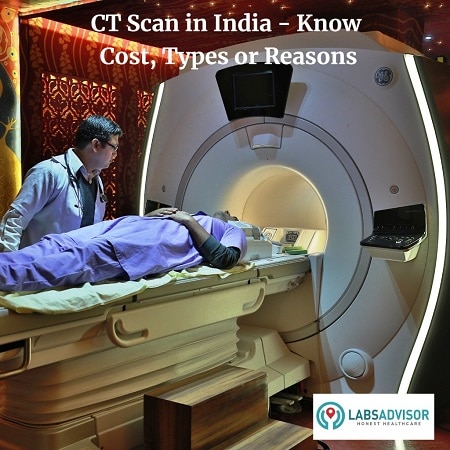
What is the procedure for a CT Scan?
A CT scan is usually done by a technician. The pictures are usually interpreted by radiologists, who write the report. Further doctors also may review a CT scan result.
During the test, the patient will be asked to lie on an examining table that is attached to the CT scanner. The narrow table slides into the round opening in the middle of the scanner, and the scanner rotates around the patient’s body. The table moves while the scanner takes pictures.
You may hear thumping, buzzing or clicking noises as the table and scanner move. It is very important to lie still during the test. The doctor will then ask you to lie face up on a table that slides into the CT scanner. Probably your face will be fitted inside a coil type structure. However, it will not harm you as it will be far from your face and will be used as a support to keep your head straight.
During the test, you will be alone in the scan room. But the radiologists will keep a watch on you through a window. You will be able to talk to the technologist through a two-way intercom. If the patient is a young child then a guardian will be allowed to stay with the child. Each rotation produces numerous images of thin slices of your body part. The table will move a few millimeters at a time until the exam is finished. The entire procedure may take about 30 to 60 minutes. The time may exceed if the patient requires a CT Scan with contrast.
It’s very important to lie still while imaging because movement can result in blurry pictures. Your doctor may ask you to hold your breath for a short period during the test to prevent your chest from moving up and down. If a young child needs a CT scan, the doctor may recommend a sedative (local anesthesia) to avoid movement.
In some cases, a dye called contrast material is used. It will be put in a vein (IV) in your arm, or it may be placed into other openings of your body such as the rectum or a joint to see those areas better. The contrast highlights the bloodstream and appears bright on the images of the area being examined.
For some types of CT scans, the patient may be asked to drink the dye. The dye makes structures and organs easier to view on the CT pictures. The test does not cause pain. If the doctor recommends on using a contrast material, they may ask you to fast for four to six hours before your CT scan.
Some people feel nervous inside the CT scanner. To make them feel relaxed a sedative (local anesthesia) is used, that is generally injected in the hand or arm. There is no side effect of the medicine but the patient may take some more time to recover from the test. The patient is being observed by the concerned radiologists and examined as soon as they recover. The patient must come with a guardian during the scan who may responsibly drop them home.
You may not experience any after-effects from a CT scan and you can eat and drink, or resume to your normal routine.
If a contrast was used, you may be advised to wait in the hospital for up to an hour to make sure you don’t have a reaction to it. The contrast is normally completely harmless and will pass out of your body while urinating.
Once the CT scan is over, the images are forwarded to an expert for analyzation of it. Your scan reports are not usually available immediately. It takes some more time to get a final report from you’re considering the doctor. A computer will need to process the information from your scan, which will then be analyzed by a radiologist. Your doctor will follow-up with you to explain the results.
What are the preparations required for a CT Scan?
There are certain requirements for a CT scan that must be considered by the patient. Such as:
- To wear loose and comfortable during the scan.
- The clothes should be simple without any embellishments, zips, glass or metallic work, snaps or any other decorative obstruction.
- To remove metal objects, such as a belt, jewelry, dentures, and eyeglasses, which may lead to an inaccuracy in the reports.
- Inform the doctor if the patient is or might be pregnant.
- Inform the doctor if the woman patient is breastfeeding.
- Introduce the doctor about the patient’s familiar allergic reactions to iodine dyes.
- Note the doctor if the patient has a heart condition, kidney problem, asthma or multiple myeloma (A cancer of plasma cells).
- If the patient is diabetic then they will have to adjust their medicine for a day before and after the test.
- Tell your doctor if you claustrophobic (fear for confined spaces).
- If the patient is a young child then the doctor may recommend a sedative (local anesthesia) to keep the child calm and still. As movement blurs the images and may lead to inaccurate results.
- If you are going to have a CT Scan with contrast then you may be advised to avoid eating anything for several hours before your appointment, to help ensure that clear images are taken.
When is a CT Scan recommended?
CT scans can produce detailed images of many structures inside the body, including the internal organs, blood vessels, and bones. Basically, it is used:
- To diagnose muscle and bone disorders like tumors and fractures.
- To study the blood vessels and other internal structures
- To locate the position of a tumor, infection or a blood clot.
- To detect internal injuries and internal bleeding.
- To lead medical procedures such as surgery, biopsy, and radiation therapy.
- To detect and monitor diseases and conditions such as cancer, heart disease, lung nodules and liver masses.
- To examine the stage of cancer or the extension of the spread.
- To track the effectiveness of the patient’s treatment pattern.
- To follow-up the done surgery such as a CT scan is done to guide a needle during a tissue biopsy or to drain an abscess.
What are the various parts of the body that can be scanned by a CT scanner?
CT Scan can be done on various body parts including chest, head, abdomen, kidneys, bones, joints, pelvis, spinal cord, liver and many more. CT Scan is used in the diagnosis of sinus, kidney stones, appendicitis, gallstones and detect the spread of cancers. It can be used to find defects in bones, fractures, infections, and injuries. It has many uses, but it is particularly well-suited for diagnosing diseases and evaluating injuries. The doctor can ask for this imaging technique for various reasons such as:
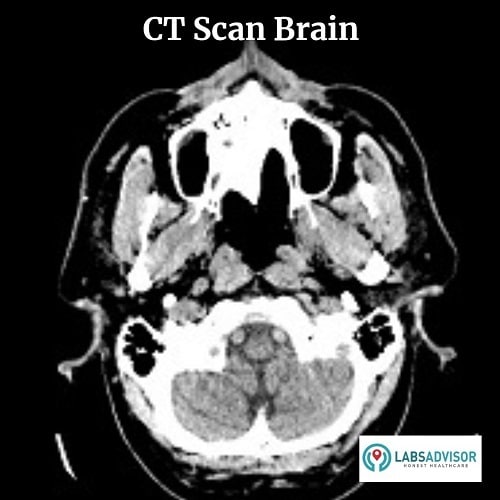
CT scan of the Head/ Brain: To find the cause of symptoms, such as confusion, paralysis, numbness, vision problems, vertigo, sudden loss of consciousness, strokes or headaches, that might mean a brain injury, a brain tumor, a ruptured aneurysm, or internal bleeding. There are other studies for the brain that can conclude the detailed information about a patient’s brain disorder such as CT Scan Brain with Perfusion. It can also help to look for problems of the middle ear bones and the auditory nerve.
It helps the doctor to plan for surgery, check on the success of treatment and provide guidance for a brain biopsy.
- CT scan in Neurology: Neurological CT scans are used to view the brain and spine. They can detect bone and vascular irregularities, certain brain tumors and cysts, herniated discs, epilepsy, encephalitis, spina bifida (a type of congenital defect of the spine), spinal stenosis (narrowing of the spinal canal), blood vessel malformations such as a blood clot or intracranial bleeding in patients with stroke, brain damage from a head injury, and other disorders. It is mainly preferred when another type of examination, such as X-rays or physical examination, is not conclusive. Some neurological disorders share common traits and a CT scan can help incorrect diagnosis by distinguishing the area of the brain affected. A CT scan of the spine is used to evaluate the further effects of the treatment of the spine and plan surgery or other therapy.
- CT scan in Cardiology: This imaging test can help doctors detect or evaluate congenital heart disease (heart problems that are present at birth) and other coronary heart diseases, blockage or calcium buildup in the coronary arteries, problems with the aorta, tumors or masses of the heart, problems with heart function and valves, and pericardial disease.
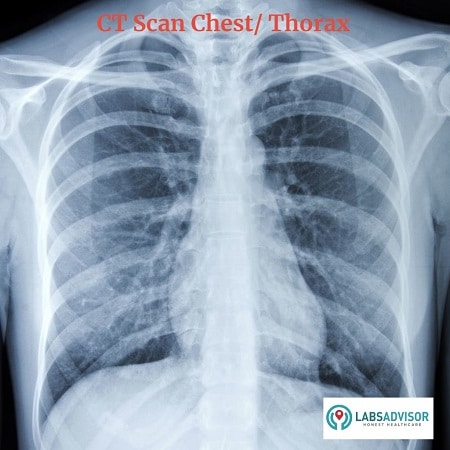
- CT Scan Chest: A CT scan also called CT Scan Thorax will inspect the lungs, heart, esophagus, or major arteries. It mainly concentrates on the lungs and is used to spot other lungs related disorders. Since Chest CT Scan gives very detailed images of lungs, it can diagnose lung cancer at early stages. It can also detect blood clots or other internal injuries.
- CT Scan Pelvis: A CT scan can look for problems in the pelvic region. For a woman organs in the pelvis includes the uterus, ovaries, and Fallopian tubes. But for a man included organs are the prostate gland and the seminal vesicles. A scan can detect various problems in that region and help in diagnosing the treatment pattern.
- CT Scan Arm or Leg: A CT scan can look for complications in the arms or legs, including the shoulder, elbow, wrist, hand, hip joints, knee joints, ankle, or foot. CT Scans are good in detecting problems related to bones.
- CT Scan ENT (Ear, Nose & Throat) and PNS (Para-Nasal Sinuses): A CT Scan looks for problems related to the eyes and the optic nerve. The test may find fractures of the bones around the eyes or detect the presence of foreign objects in the eye. It also looks for problems or diseases related to nasal bones that are air-filled cavities where mucus gets collected and bother the patient.
A CT Scan Orbit looks for issues with the bones and joints of the jaw, face, and skull, such as a temporomandibular disorder or Paget’s disease. It also helps in planning a surgery to rebuild parts of the face that were damaged.
- CT Scan Urinary Tract/ KUB: A CT scan of the kidneys, ureters, and bladder is called a CT KUB or CT Urogram. This type of scan can find kidney stones, bladder stones, or any blockage in the urinary tract. It can also evaluate for any abnormal growth, infection, or other diseases of the urinary tract.
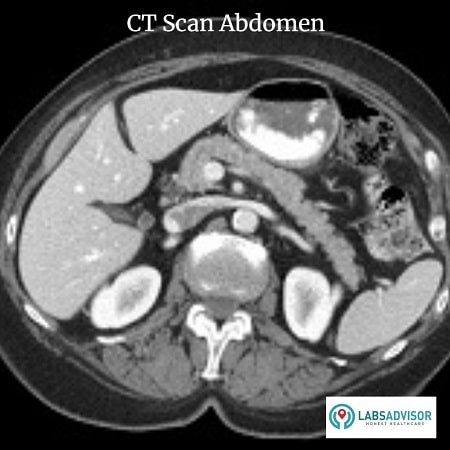
- CT Scan Abdomen: A CT scan of the abdomen can find cysts, abscesses, infection, tumors, an aneurysm, enlarged lymph nodes, foreign objects, bleeding in the belly, diverticulitis, inflammatory bowel disease, and appendicitis. CT scan of Abdomen includes scanning of:
- Liver: A CT scan can determine liver tumors, internal bleeding from the liver, and other liver diseases. A CT scan of the liver can evaluate the cause of jaundice.
- Pancreas: A CT scan can find a tumor in the pancreas or inflammation of the pancreas (pancreatitis).
- Gallbladder and bile ducts: A scan can be done to detect for blockage in the bile ducts. But other imaging procedures, such as ultrasound, usually are used to find problems related to the gallbladder and bile ducts.
- Adrenal glands: While scanning adrenal glands a doctor can find tumors or enlarged adrenal glands.
- Spleen: A scan can check for an injury to the spleen or the improper size and shape of the spleen.
Why is a CT Scan preferred than an MRI Scan?
- A CAT scan uses X-rays beams to build up a picture. Whereas an MRI uses a powerful magnetic field to do the same and has no side effects related to radiation exposure.
- MRI gives higher detail in soft tissues whereas CT is very good for imaging bone structures
- For purposes of tumor detection and identification, MRI is generally superior. However, CT Scan is more widely available, can complete the procedure faster, costs much less and is less likely to require the person to be sedated.
- CT Scan imaging can be enhanced by the use of contrast agents containing elements such as iodine or barium that can surround flesh as soon it is transferred to the blood vessels. MRI Scan uses nuclear agents containing magnetic properties such as Gadolinium. Iodine usage may be associated with allergic reactions.
- MRI Scan is not suitable for the patients who are claustrophobic as they have to stay inside the noisy MRI machine for around 30 minutes, on the other hand, CT scanner has an opening on both the sides and suitable for the patients who are claustrophobic
What are the benefits of a CT Scan?
- CT scans are fast, painless, and generally safe.
- It provides a wealth of clear and specific information that helps the doctor to locate the affected area easily.
- In emergency cases, they can reveal internal injuries and bleed quickly enough and avoid further unnecessary surgeries.
- CT scan avails rapid acquisition of images as compared to the other radiology imaging tests.
- The amount of radiation exposure during a CT scan varies, depending on how much of your body is scanned. CT scanners are designed to lessen unnecessarily high levels of radiation exposure.
- It is a cost-effective imaging tool for a wide range of clinical problems.
- CT scan can be performed if you have an implanted medical device of any kind, unlike MRI.
- CT Scans can be performed easily if the patient moves, as CT scanners are less sensitive to movements.
- A diagnosis evaluated by CT scanning may decrease the need for any unnecessary surgery and surgical biopsy.
- No radiation remains in a patient’s body after a CT examination.
- X-rays used in CT scans usually have no side effects.
- CT images show the surgeons exactly where to operate as it covers a large part of the body.
- CT scanning provides another aspect of medical information unlike other imaging techniques, such as ultrasound, MRI, SPECT, PET, or nuclear medicine.
The benefits of having a CT scan is always weighed up by its risks. If you have any doubts then talk to your concerned doctor about the potential risks beforehand.
What are the risk factors for a CT scan?
- The contrast dye can make you feel warm and may give you a metallic taste. Some people may feel sick to their stomach or get a headache.
- However, there’s a small risk you could have an allergic reaction to the contrast dye used and you will be exposed to X-ray radiation.
- Most reactions are mild and result in a rash or itchiness. In rare instances, an allergic reaction can be serious, even life-threatening.
- CT scan with contrast is not usually done during pregnancy.
- Items such as surgical clips, metal objects in the head, aneurysm clips, or foreign bodies, may prevent a clear view of the affected area.
- If you have diabetes or take metformin (Glucophage), the dye may cause problems. Your doctor will tell you when to stop taking metformin for a short duration before or after the test.
What are the possible interpretations of a CT Scan?
You can collect your CT Scan results within 1 to 2 days. Your doctor is in the right position to interpret your reports.
Typically an abnormal CT Scan report can be about:
- An enlarged large or too small organ,
- Damaged, fractured bone or infected organ and tissue,
- Presence of cysts or abscesses,
- Presence of foreign objects,
- Presence of kidney stones or gallstones,
- Inappropriate growths, such as tumors that are usually found in the colon, lungs, ovaries, liver, kidneys, ureter, bladder, adrenal gland, or pancreas.
- Pulmonary embolism, fluid in the lungs, or infection.
- Blockage in the intestines/ colon,
- Inflammatory bowel disease,
- Enlarged Lymph nodes,
- Blockage in blood vessels
A Head CT Scan can show abnormalities in or around the brain. The abnormal report normally shows damaged or pinched nerves leading to or from the brain. The openings in the brain (ventricles) through which cerebrospinal fluid flows into the spine are enlarged. An affected area of the brain shows edema (swelling) or other changes that may indicate a stroke. If a collection of fluid is found, which may mean bleeding in or around the brain.
Other topics you may be interested in:-
- CT Scan Cost in Delhi
- CT Scan Cost in Gurgaon
- CT Scan Cost in Bangalore
- CT Scan Cost in Mumbai
- CT Scan Cost in Hyderabad
- CT Scan Cost in Chennai
- CT Scan Cost in Pune
- CT Scan Cost in Lucknow







If your CT scan is not listed in the table above, call us on +918061970525. We will get back to you with the CT scan cost near your location in India.
Get the lowest CT scan price in India by calling us at
☏+918061970525
If you want us to call you back, click on the link below